Ground-Nesting Bees Should Be Appreciated, Not Feared!
go.ncsu.edu/readext?994168
en Español / em Português
El inglés es el idioma de control de esta página. En la medida en que haya algún conflicto entre la traducción al inglés y la traducción, el inglés prevalece.
Al hacer clic en el enlace de traducción se activa un servicio de traducción gratuito para convertir la página al español. Al igual que con cualquier traducción por Internet, la conversión no es sensible al contexto y puede que no traduzca el texto en su significado original. NC State Extension no garantiza la exactitud del texto traducido. Por favor, tenga en cuenta que algunas aplicaciones y/o servicios pueden no funcionar como se espera cuando se traducen.
Português
Inglês é o idioma de controle desta página. Na medida que haja algum conflito entre o texto original em Inglês e a tradução, o Inglês prevalece.
Ao clicar no link de tradução, um serviço gratuito de tradução será ativado para converter a página para o Português. Como em qualquer tradução pela internet, a conversão não é sensivel ao contexto e pode não ocorrer a tradução para o significado orginal. O serviço de Extensão da Carolina do Norte (NC State Extension) não garante a exatidão do texto traduzido. Por favor, observe que algumas funções ou serviços podem não funcionar como esperado após a tradução.
English
English is the controlling language of this page. To the extent there is any conflict between the English text and the translation, English controls.
Clicking on the translation link activates a free translation service to convert the page to Spanish. As with any Internet translation, the conversion is not context-sensitive and may not translate the text to its original meaning. NC State Extension does not guarantee the accuracy of the translated text. Please note that some applications and/or services may not function as expected when translated.
Collapse ▲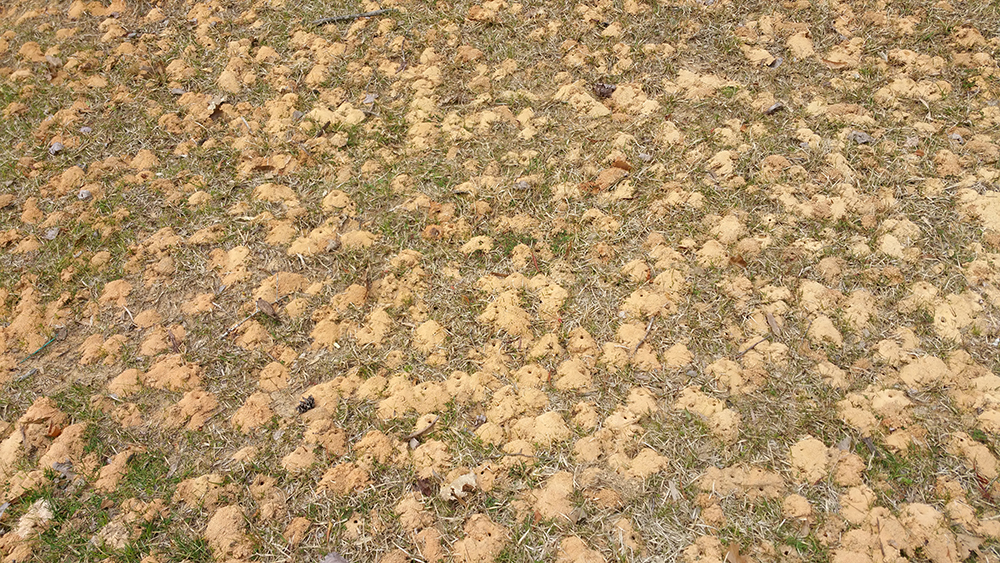
Large aggregation of mining bee nests. Photo by Debbie Roos.
Usually in early spring I start getting calls from people nervous about seeing hundreds of bees hovering over their lawn. Actually they aren’t sure if they are bees or wasps but their primary concern is that someone will get stung. Several folks over the years have told me about the environmentally toxic methods they have used to destroy the bee nests which is unfortunate because not only are they poisoning their soil and potentially their groundwater but they are also needlessly killing off a beneficial early season pollinator that poses no threat to humans.
We have approximately 560 species of native bees in North Carolina, and about 70% of them, close to 400 species, nest in the ground. The vast majority of bees are solitary, meaning they work alone to provision their nest with food (pollen) to raise their young, unlike social bees (e.g., honey bees and bumble bees) which work together as a colony to raise their brood.
Ground-nesting bees can be found in different types of soil from sandy to clay in sparsely vegetated areas like lawns with patchy grass. Slopes can be attractive to ground-nesting bees because they are well-drained and dry out quickly.
Examples of ground-nesting bees include mining bees (genus Andrena), cellophane bees (genus Colletes), sweat bees (genus Halictus and Lasioglossum), metallic green sweat bees (genus Agapostemon), digger bees (genus Anthophora and Habropoda), long-horned bees (genus Svastra, Melissodes, and Peponapis), and mallow bees (genus Melitoma and Ptilothrix).
Most native bees are not picky about where they collect their pollen but about 25% of our native bees are pollen specialists. On one end of the continuum there are the polylectic bees that will collect pollen from unrelated plants; the more specialized oligolectic bees will collect pollen from plants in the same family or related genera; and the most specialized bees are the monolectic bees which only collect pollen from a single genus or species of plant.
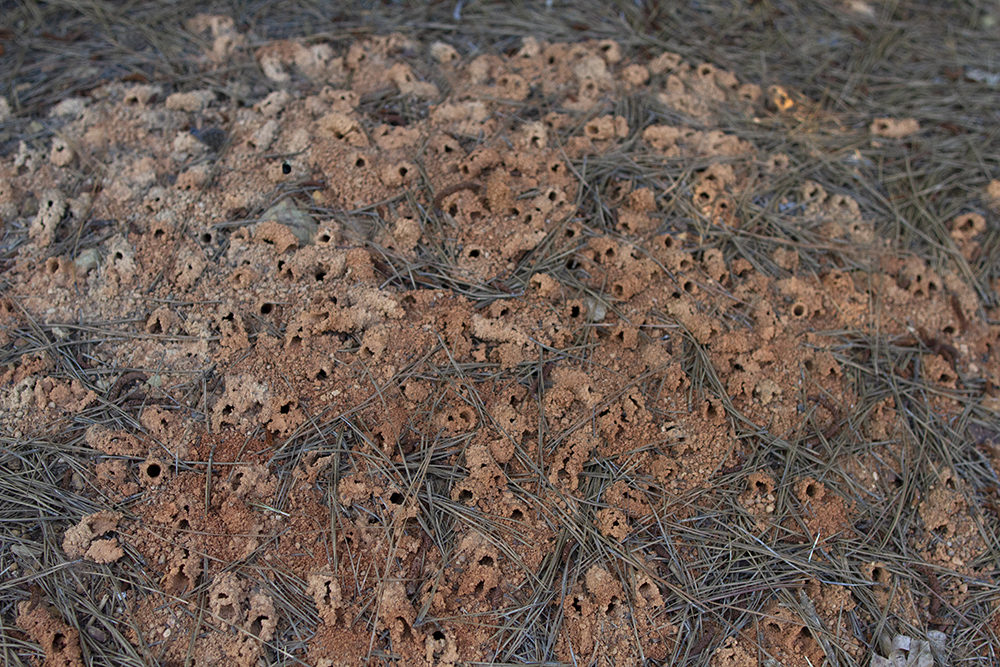
Aggregation of chimney bee nests in mid-May. Chimney bees are a type of digger bee and are polylectic which means they collect pollen from a wide range of plants. The females will reuse nesting sites year after year. Photo by Debbie Roos.

Close-up of chimney bee nests. The female chimney bees use the excavated soil to build “turrets” or chimneys over the nest entrance. Photo by Debbie Roos.

A male chimney bee (at upper left in photo) hovers over a nest entrance hoping to mate with a female returning to the nest with pollen. Photo by Debbie Roos.
Here’s a little video clip of some chimney bees (Anthophora abrupta) that I shot a while back. So much activity…I love watching the females enter and exit the nests. I recommend you expand this to full screen mode to see all the comings and goings.
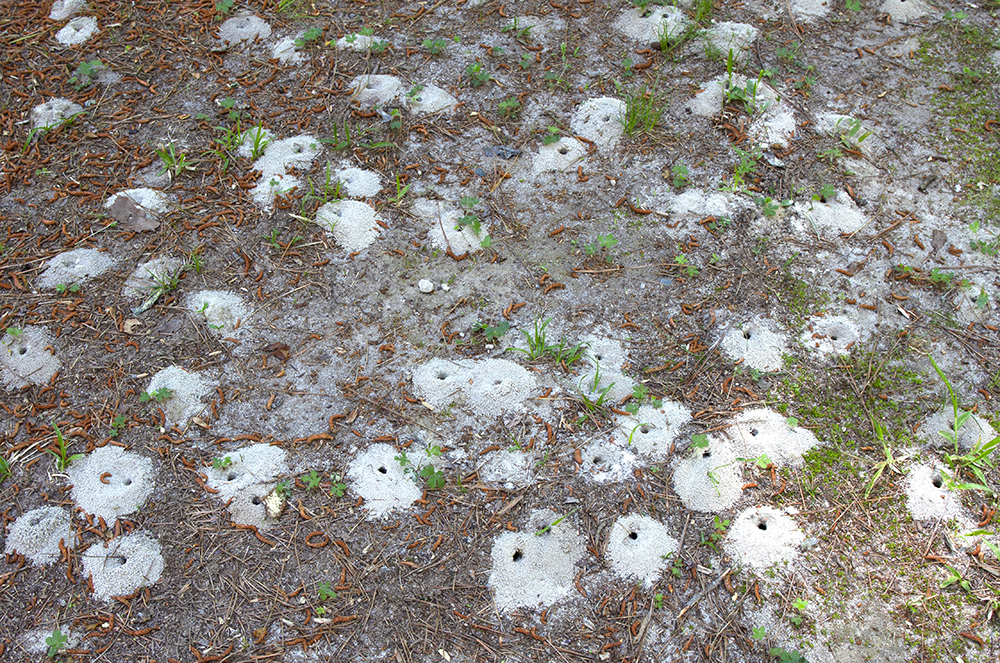
Cellophane bee nests in early May. Cellophane bees, also called polyester bees or plasterer bees, line their nests with a waterproof material that resembles clear plastic (cellophane) when it dries. Photo by Debbie Roos.
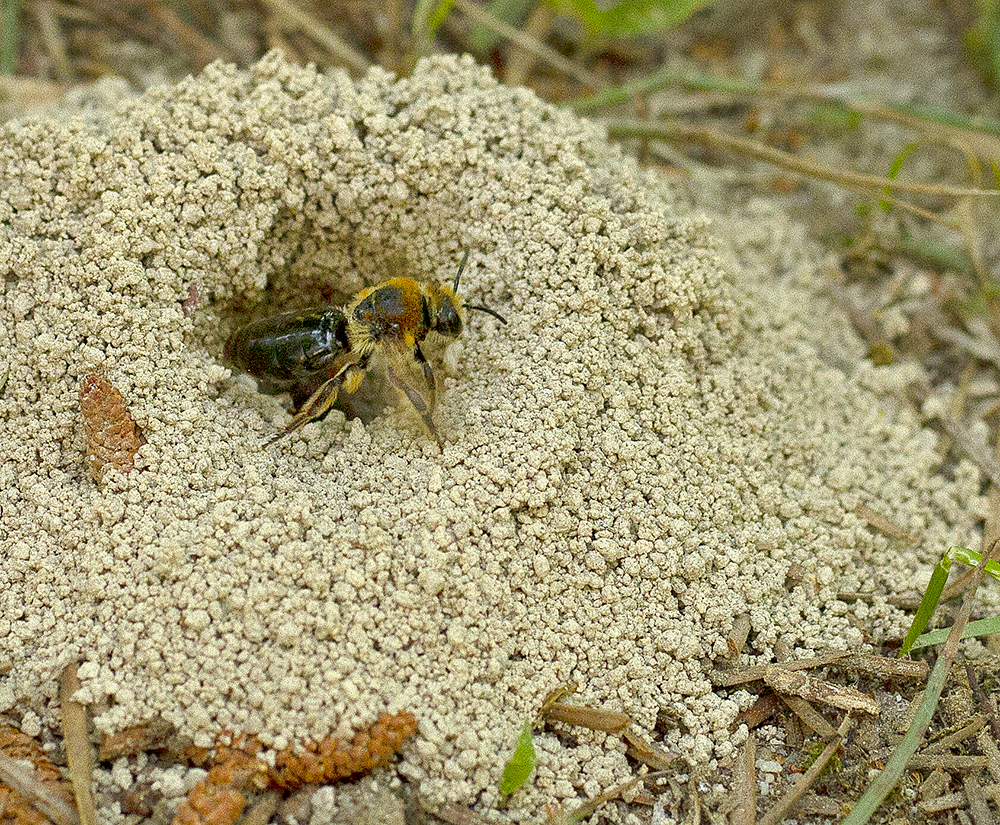
Rufous-backed cellophane bee at nest entrance. Photo by Debbie Roos.
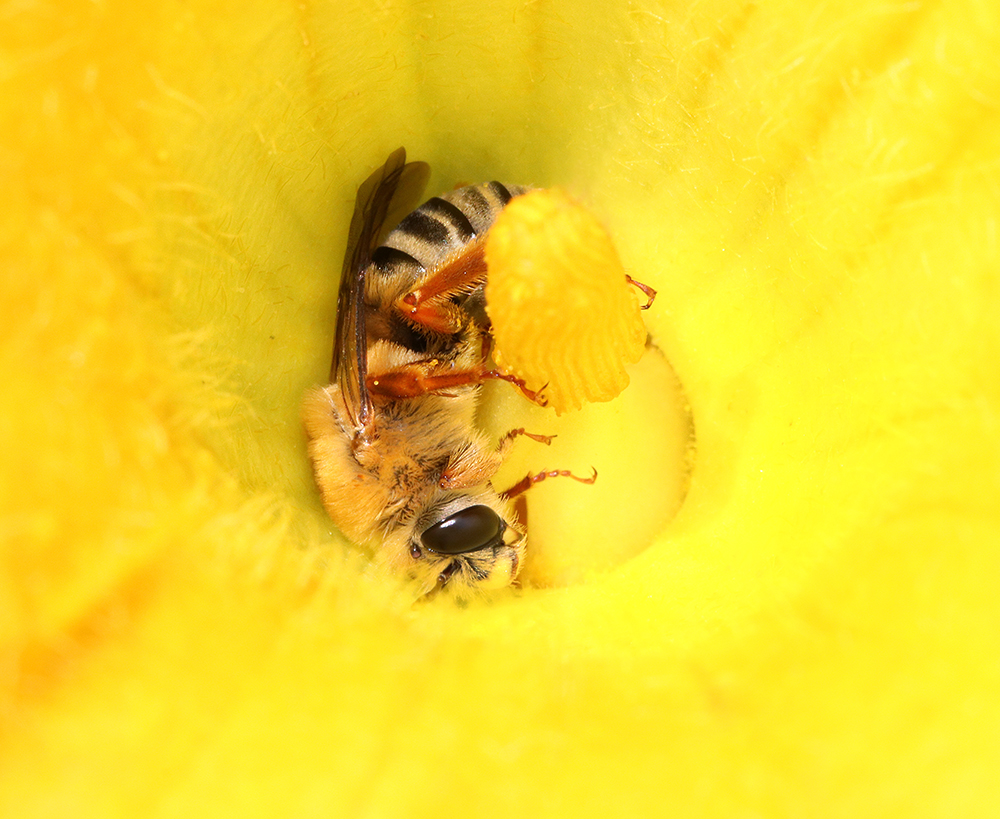
Female squash bee in a squash bloom. These bees nest in the ground near squash plants. Squash bees are oligolectic and only collect pollen from plants in the Cucurbit family. Photo by Debbie Roos.
As a group ground-nesting bees are active from February through November in North Carolina, although each species usually has a fairly short time period that it provisions its nest.
For example, some of the earliest and most visible bees are the mining bees (genus Andrena) that start nesting in late February/early March. There are close to 100 species of mining bees in North Carolina! These are the bees I get the most phone calls about because they often nest in large aggregations and folks sometimes get concerned when they see so many tiny mounds of excavated soil in their lawn with hundreds of bees flying back and forth and hovering over the nest entrances. They worry their kids will get stung. This is not a concern with the mining bees for several reasons. Most of the bees seen hovering over the nests are males waiting to mate with the female bees and males don’t have stingers. Mining bees are solitary bees and their ovipositor is needed for laying eggs so is not adapted for stinging. For social bees like bumble bees and honey bees where only the queen bee lays eggs, the ovipositor of the female worker bees has evolved into a stinger to defend the nest from intruders. I have personally spent many hours on multiple occasions over the years observing ground-nesting bees and have never been stung.
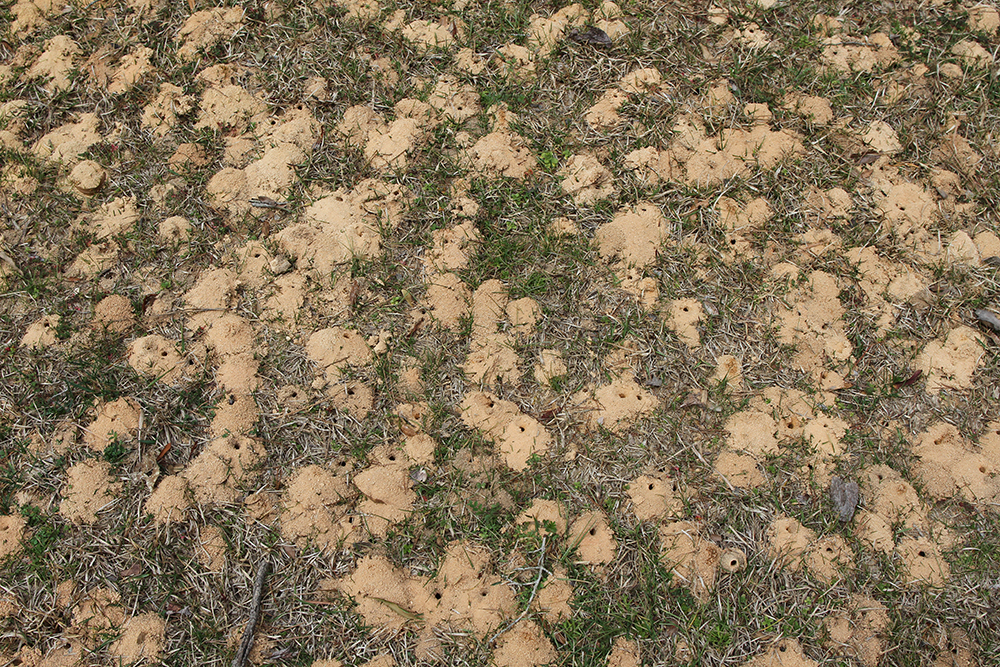
Large aggregation of mining bee nests in mid-March. Photo by Debbie Roos.
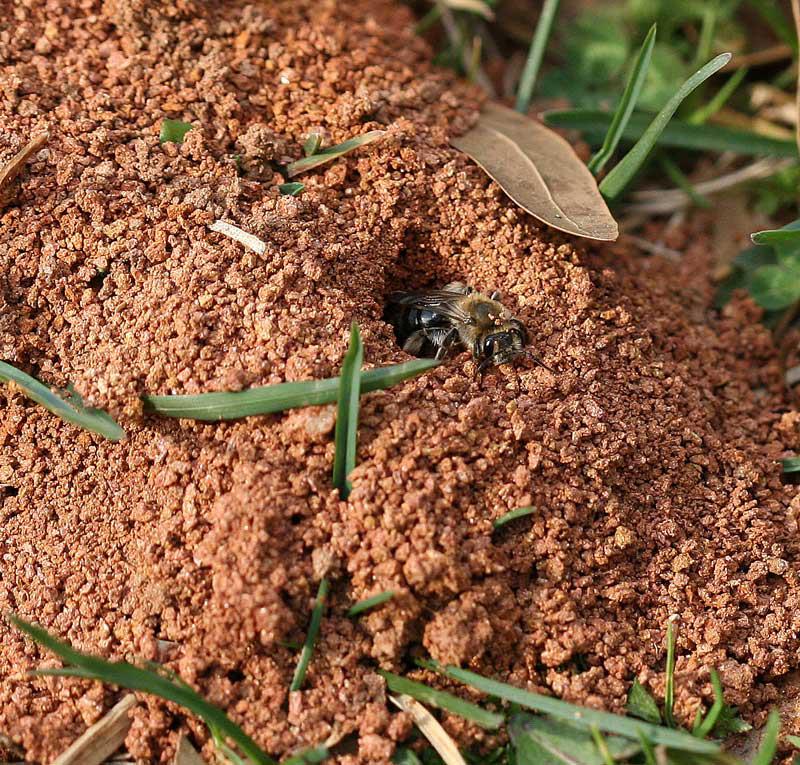
Mining bee emerging from her nest to go collect more pollen. Photo by Debbie Roos.
These mining bees are actively nesting from about early March to around mid-April. They are important pollinators and provision their nests with pollen from early blooming plants. The female bee digs a branching tunnel underground and prepares a brood cell, collects pollen, mixes it with nectar, forms it into a ball and lays an egg. She then seals off the brood cell and starts another one. After several weeks of active pollen foraging the female bee dies. When the larva hatches it consumes the pollen/nectar mixture and develops throughout the year and then the next generation emerges the following spring. The bees often reuse the same nesting sites year after year.

Mining bee foraging on possumhaw (Ilex decidua). Photo by Debbie Roos.

Mining bee foraging on golden alexander (Zizia aurea). Photo by Debbie Roos.
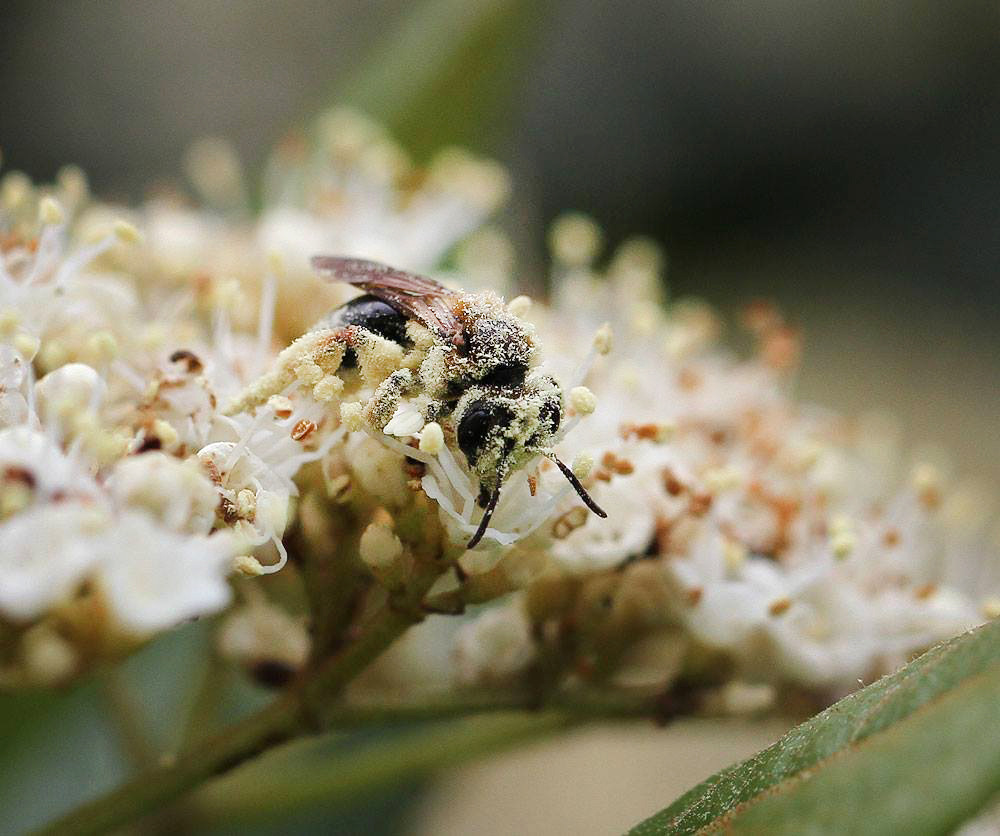
Mining bee covered in pollen while foraging on possumhaw viburnum (Viburnum nudum). Photo by Debbie Roos.
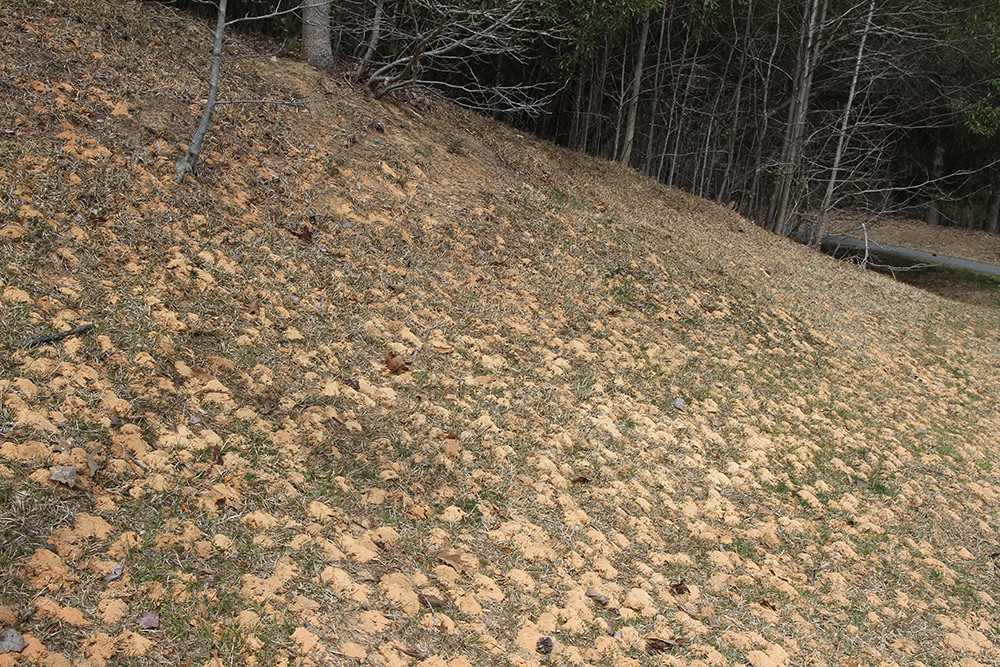
Mining bee nest aggregation on a slope in mid-March. Photo by Debbie Roos.
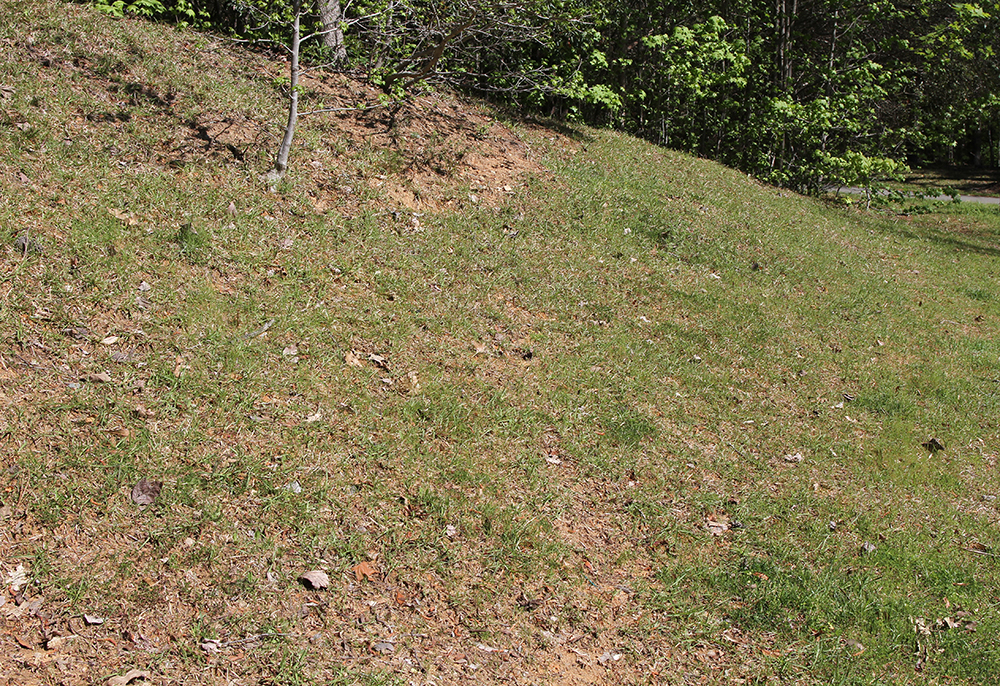
Same slope as above in mid April showing no evidence of nesting activity above ground. By mid-April the foraging female has finished provisioning the nests below ground and died and the rains have washed away the little mounds of excavated soil. The underground larvae continue developing throughout the year. Photo by Debbie Roos.
I was excited in 2023 to spot an uncommon mining bee species in my pollinator garden, the passionflower bee (Anthemurgus passiflorae). This solitary ground-nesting native andrenid bee is monolectic, meaning it only collects pollen from a single species, in this case the yellow passionflower (Passiflora lutea). The female carries the pollen on scopa (branched hairs) on her hind legs, then packs the pollen into a flattened mass in underground tunnels and lays an egg on it for the larva to feed on. Read more about the passionflower bee.
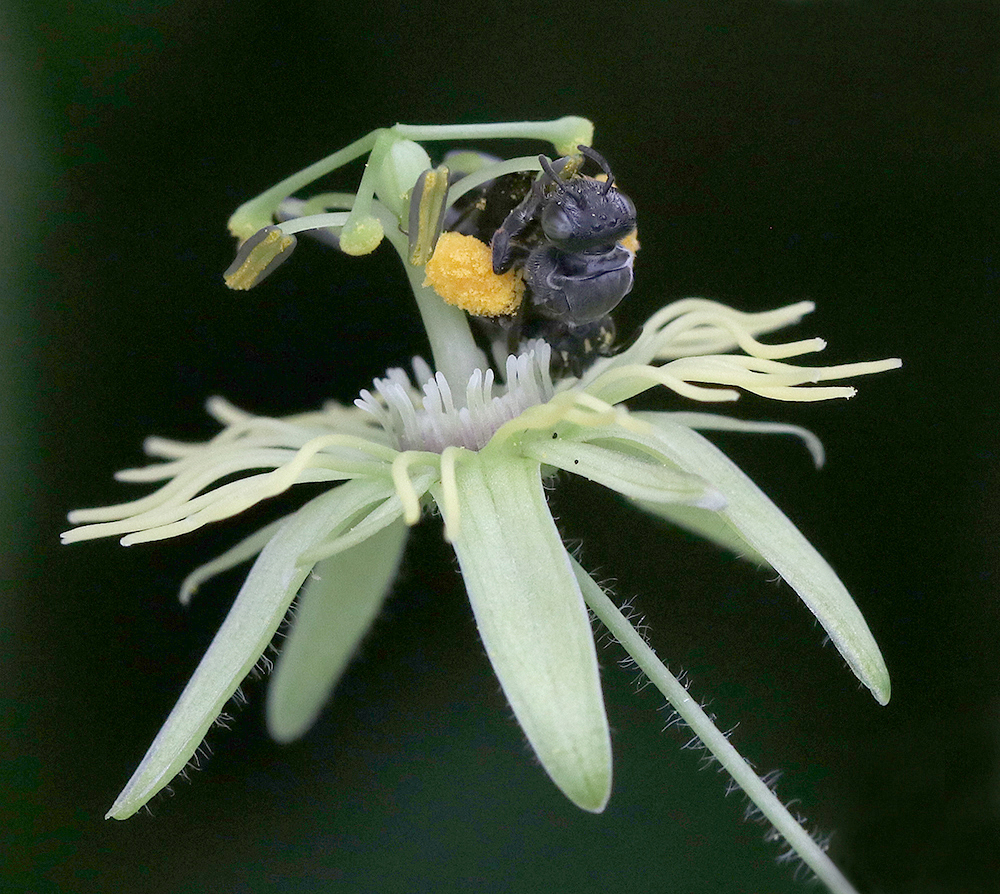
Passionflower bee foraging on yellow passionflower (Passiflora lutea). Photo by Debbie Roos.
Protecting and/or Creating Ground Nesting Bee Habitat
If you find ground nesting bees in your yard hopefully you can take efforts to protect them during the crucial nest provisioning stage. If the female bees are allowed to complete their provisioning duties uninterrupted without any disturbance to the nests, then the bees stand an excellent chance of raising the next generation. You want to avoid walking or driving over the nesting site during the active provisioning period when you can see bees flying around (the months vary by species) and at no point during the year would you want to dig up the soil because that would destroy the underground tunnels where the bees are developing.

At Northwest Park in Chatham County, the area where mining bees are nesting is temporarily fenced off during the active nest provisioning season (early March to mid-April) so the nests are protected from foot traffic during this vulnerable period. Once the provisioning period is over, regular above-ground activities can resume with no harm to the developing bees below ground. Signs inform the public about the beneficial pollinators and direct them to this webpage for more information. Photo by Debbie Roos.
If you would like to encourage or create habitat for ground nesting bees in your yard, look for sunny, well-drained spots that have sparse vegetation. If you have a gentle south facing slope that would be ideal. It’s good to have some low-growing grasses or other vegetation to prevent erosion but you need some open spots with bare soil. Rocks are good too as some research has suggested that bees prefer nesting among rocks.
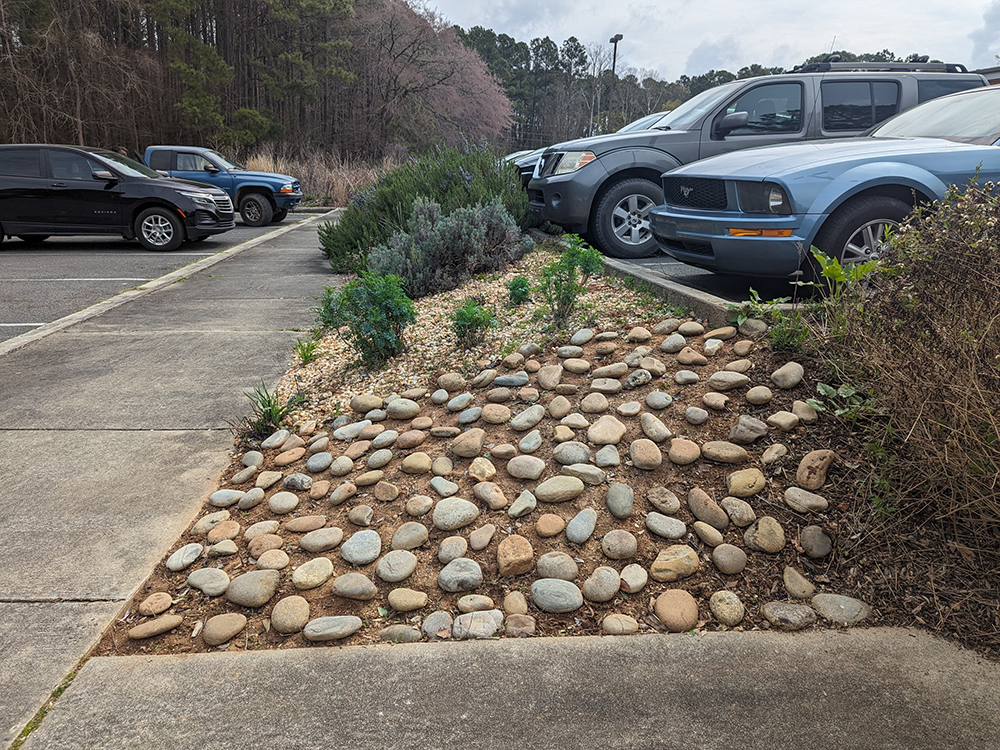
Ground-nesting bee habitat created in the Pollinator Paradise Garden in Pittsboro. Bare soil provides access for ground nesting bees to create underground nesting sites. Photo by Debbie Roos.


